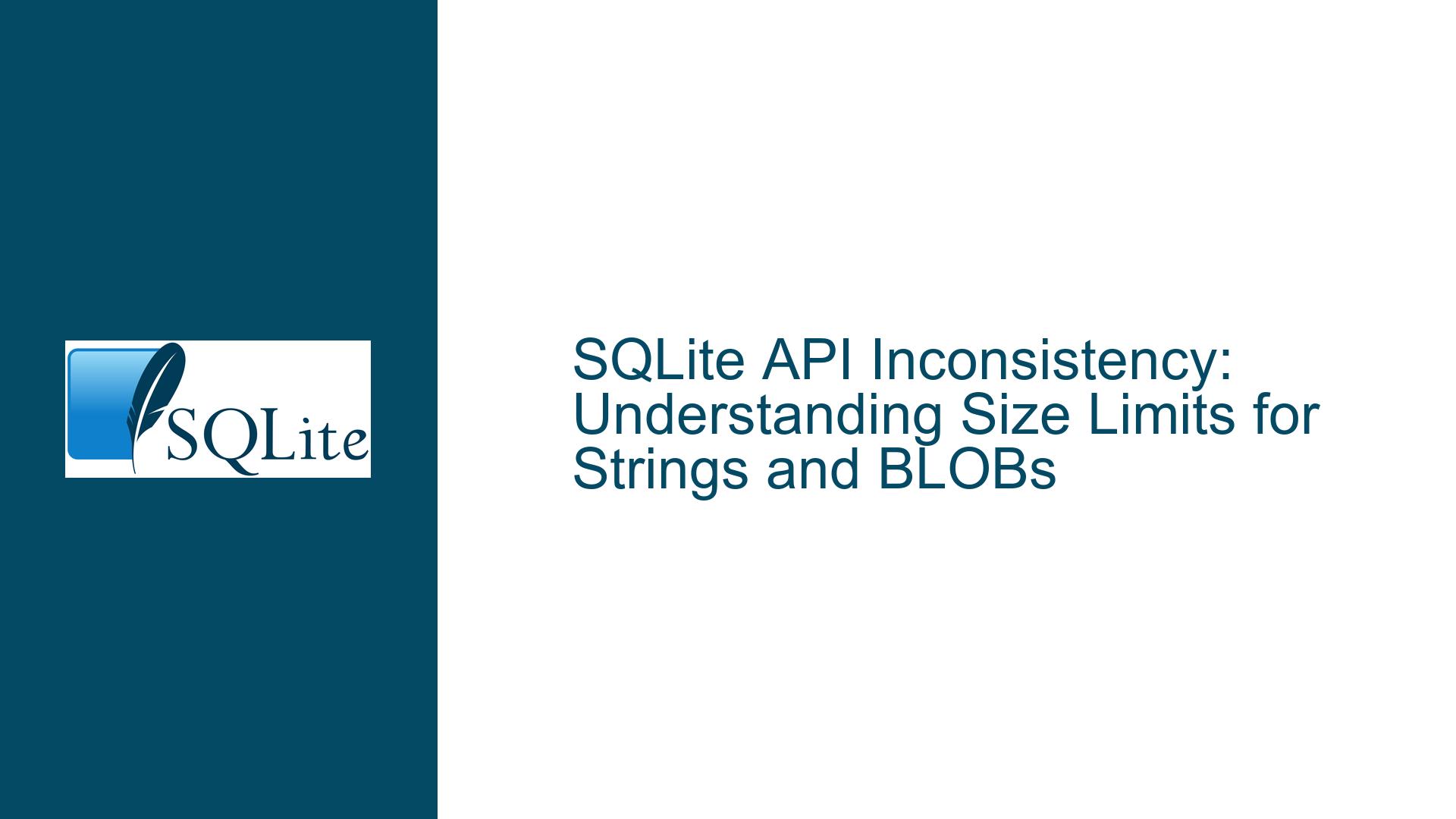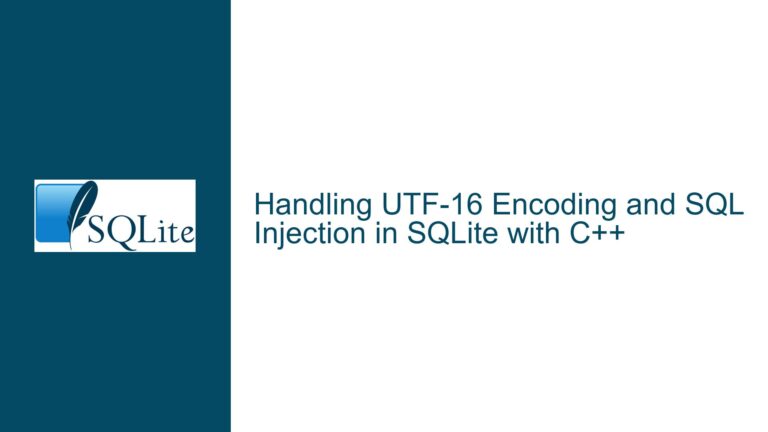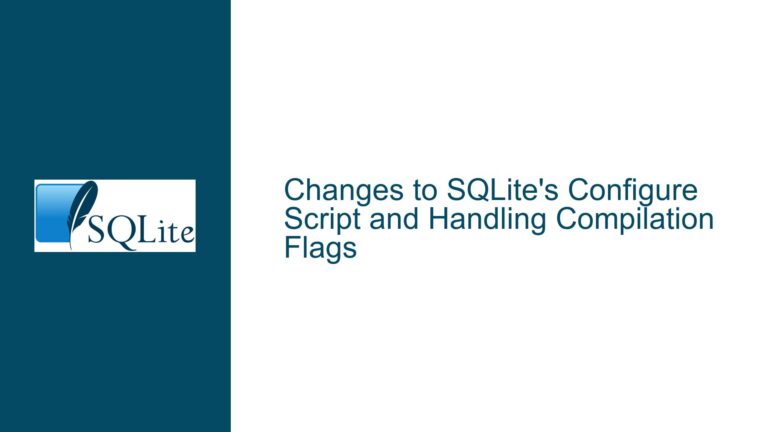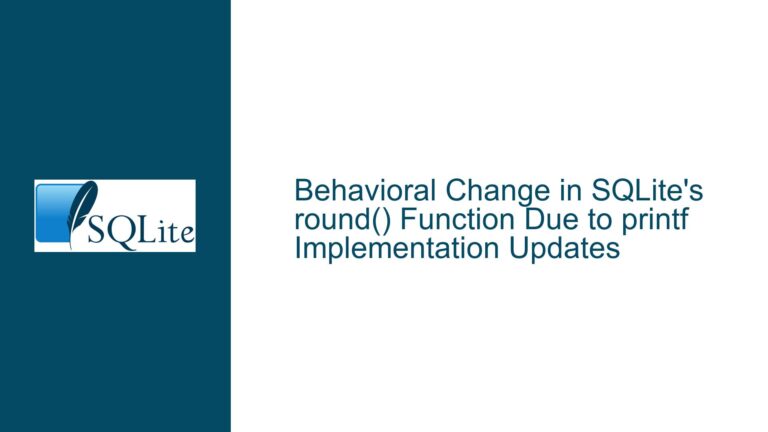SQLite API Inconsistency: Understanding Size Limits for Strings and BLOBs
SQLite’s Size Limits for Strings and BLOBs: A Deep Dive into the API Inconsistency
SQLite is a lightweight, serverless database engine that is widely used in applications ranging from embedded systems to web browsers. One of its strengths lies in its simplicity and robustness, but like any software, it has its nuances. A particularly subtle area of SQLite’s API involves the handling of size limits for strings and BLOBs (Binary Large Objects). While the API provides functions to bind and retrieve text and BLOB data, there are inconsistencies in how size limits are enforced and reported. This post will explore the issue in detail, covering the underlying causes, the implications for developers, and how to navigate these inconsistencies effectively.
The Hard Upper Bound: SQLite’s 32-bit Size Limit for Strings and BLOBs
At the core of the issue is SQLite’s file format, which imposes a hard upper bound of 2,147,483,647 bytes (2^31 – 1) for the length of any string or BLOB. This limit is a direct consequence of SQLite’s internal representation of data sizes using 32-bit integers. Despite the availability of 64-bit platforms and the increasing demand for handling larger datasets, SQLite maintains this limit to ensure compatibility and consistency across all platforms.
The sqlite3_limit function, which is used to query and set various runtime limits in SQLite, returns a 32-bit integer for the SQLITE_LIMIT_LENGTH limit. This limit defines the maximum size of any string, BLOB, or table row in bytes. Given the hard upper bound of 2,147,483,647 bytes, the value returned by sqlite3_limit will always fit within a 32-bit integer. This design choice ensures that the limit can be represented consistently across all platforms, regardless of whether they are 32-bit or 64-bit.
However, this leads to an apparent inconsistency when considering the sqlite3_bind_text64 and sqlite3_bind_blob64 functions. These functions accept a sqlite3_uint64 parameter for the length of the text or BLOB being bound. At first glance, this might suggest that SQLite supports text and BLOB sizes larger than the 32-bit limit. However, this is not the case. The 64-bit length parameter is provided to avoid integer overflow issues in the application code, not to allow for larger data sizes.
For example, consider an application that needs to bind a text string with a length of size + 100. If the size variable is a 64-bit integer, adding 100 to it could result in an overflow if the result exceeds the maximum value that can be represented by a 32-bit integer. By accepting a 64-bit length parameter, sqlite3_bind_text64 and sqlite3_bind_blob64 allow the application to perform such calculations without worrying about overflow, even though the actual size of the text or BLOB being bound cannot exceed the 32-bit limit.
The Missing sqlite3_column_bytes64: Why SQLite Doesn’t Need It
Another point of confusion arises from the absence of a sqlite3_column_bytes64 function. The sqlite3_column_bytes function returns the size of a text or BLOB column as a 32-bit integer. Given that the maximum size of a text or BLOB in SQLite is 2,147,483,647 bytes, a 32-bit integer is sufficient to represent the size. Therefore, there is no need for a 64-bit variant of this function.
The lack of a sqlite3_column_bytes64 function is consistent with SQLite’s design philosophy of simplicity and minimalism. Adding a 64-bit variant would introduce unnecessary complexity without providing any practical benefit, as the size of any text or BLOB in SQLite cannot exceed the 32-bit limit. Developers should be aware of this limitation and ensure that their applications handle text and BLOB sizes accordingly.
Navigating the Inconsistency: Best Practices for Handling Text and BLOB Sizes in SQLite
Given the constraints imposed by SQLite’s file format and the design of its API, developers need to adopt certain best practices when working with text and BLOB sizes. These practices will help avoid common pitfalls and ensure that applications behave correctly within the limits of SQLite.
First and foremost, developers should always be aware of the hard upper bound of 2,147,483,647 bytes for text and BLOB sizes. This limit applies regardless of the platform or the specific API functions being used. When binding text or BLOB data using sqlite3_bind_text64 or sqlite3_bind_blob64, developers should ensure that the length parameter does not exceed this limit. While the 64-bit length parameter allows for safer calculations, the actual size of the data being bound must still fit within the 32-bit limit.
Second, developers should use the sqlite3_limit function to query the current limit for SQLITE_LIMIT_LENGTH and adjust it if necessary. This function provides a way to enforce size limits at runtime, ensuring that applications do not inadvertently attempt to store text or BLOB data that exceeds the maximum allowed size. By setting an appropriate limit, developers can prevent errors and improve the robustness of their applications.
Third, when retrieving the size of a text or BLOB column using sqlite3_column_bytes, developers should be aware that the returned value will always be a 32-bit integer. There is no need to handle 64-bit sizes, as the maximum size of any text or BLOB in SQLite is well within the range of a 32-bit integer. This simplifies the code and reduces the potential for errors related to integer overflow or truncation.
Finally, developers should consider the implications of SQLite’s size limits when designing their database schemas and application logic. For example, if an application needs to store large amounts of text or binary data, it may be necessary to split the data into smaller chunks that fit within the 32-bit limit. Alternatively, developers could use external storage for large files and store only references to those files in the database. By carefully considering these design choices, developers can work within SQLite’s constraints while still meeting the needs of their applications.
Conclusion: Embracing SQLite’s Constraints for Robust and Efficient Applications
SQLite’s handling of size limits for strings and BLOBs is a reflection of its design philosophy: simplicity, consistency, and compatibility. While the API may appear inconsistent at first glance, these inconsistencies are the result of careful design choices that prioritize robustness and ease of use. By understanding the underlying constraints and adopting best practices, developers can effectively navigate these nuances and build applications that are both efficient and reliable.
The key takeaway is that SQLite’s 32-bit size limit for strings and BLOBs is a fundamental aspect of its file format and cannot be circumvented. The 64-bit length parameters in sqlite3_bind_text64 and sqlite3_bind_blob64 are provided to prevent integer overflow in application code, not to allow for larger data sizes. Developers should always be mindful of this limit and design their applications accordingly.
By following the best practices outlined in this post, developers can ensure that their applications handle text and BLOB sizes correctly, avoid common pitfalls, and make the most of SQLite’s capabilities. Whether you’re working on an embedded system, a mobile app, or a web application, understanding these nuances will help you build more robust and efficient solutions with SQLite.






